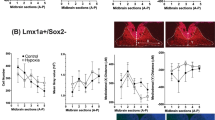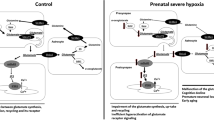Abstract
Prenatal hypoxia (PHX) is a well-known environmental factor implicated in the pathophysiology of schizophrenia. However, the long-term effects of PHX on schizophrenia-related neuroplasticity are poorly understood. Using behavioral tasks, MRI imaging, and biochemical studies, we examined the long-term effects of PHX in heterozygous reeler mice (HRM; mice deficient for reelin, a candidate gene for schizophrenia). PHX at E17 failed to induce any significant deficits in prepulse inhibition, spatial memory, anxiety-like behavior, or blood flow in wild type (WT) and HRM at 6 months of age. However, PHX induced a significant increase in frontal cortex volume in WT whereas the higher frontal cortical volume found in HRM was significantly reduced by PHX. A significant decrease in reelin levels was observed in frontal cortex of WT and HRM and hippocampus of HRM following PHX. In addition, PHX induced significant reductions in hypoxia inducible factor-1α (HIF-1α) levels in frontal cortex and hippocampus of HRM. Although no significant effect of PHX was observed in vascular endothelial growth factor (VEGF) protein levels in frontal cortex and hippocampus of WT and HRM, serum VEGF levels were found higher in HRM following PHX. Moreover, glucocorticoid receptor (GR) protein levels were significantly lower in frontal cortex of WT and HRM and hippocampus of HRM following PHX. We found a significant reduction in serum corticosterone levels of PHX-treated WT mice. These findings suggest that future experiments addressing gene–environment interaction in schizophrenia should consider age-dependent effects of the environmental factor, in addition to the specificity of the gene of interest.







Similar content being viewed by others
References
Lillrank SM, Lipska BK, Weinberger DR (1995) Neurodevelopmental animal models of schizophrenia. Clin Neurosci 3(2):98–104
Bayer TA, Falkai P, Maier W (1999) Genetic and non-genetic vulnerability factors in schizophrenia: the basis of the “two hit hypothesis”. J Psychiatr Res 33(6):543–548
Marenco S, Weinberger DR (2000) The neurodevelopmental hypothesis of schizophrenia: following a trail of evidence from cradle to grave. Dev Psychopathol 12:501–527
Fatemi SH, Folsom TD (2009) The neurodevelopmental hypothesis of schizophrenia, revisited. Schizophr Bull 35(3):528–548
Rapoport JL, Addington AM, Frangou S, Psych MR (2005) The neurodevelopmental model of schizophrenia: update 2005. Mol Psychiatry 10(5):434–449
Harrison PJ, Weinberger DR (2005) Schizophrenia genes, gene expression, and neuropathology: on the matter of their convergence. Mol Psychiatry 10(1):40–68
Demjaha A, MacCabe JH, Murray RM (2011) How genes and environmental factors determine the different neurodevelopmental trajectories of schizophrenia and bipolar disorder. Schizophr Bull
Clarke MK, Harley M, Cannon M (2006) The role of obstetric events in schizophrenia. Schizophr Bull 32(1):3–8
Nicodemus KK, Marenco S, Batten AJ, Vakkalanka R, Egan MF, Straub RE, Weinberger DR (2008) Serious obstetric complications interact with hypoxia-regulated/vascular-expression genes to influence schizophrenia risk. Mol Psychiatry 13(9):873–877
Boksa P (2004) Animal models of obstetric complications in relation to schizophrenia. Brain Res Rev 45:1–17
Van Erp TG, Saleh PA, Rosso IM, Huttunen M, Lönnqvist J, Pirkola T, Salonen O, Valanne L et al (2002) Contributions of genetic risk and fetal hypoxia to hippocampal volume in patients with schizophrenia or schizoaffective disorder, their unaffected siblings, and healthy unrelated volunteers. Am J Psychiatry 159:1514–1520
Schmidt-Kastner R, van Os J, Steinbusch HWM, Schmitz C (2006) Gene regulation by hypoxia and the neurodevelopmental origin of schizophrenia. Schizophr Res 84(2–3):253–271
Hoeben A, Landuyt B, Highley MS, Wildiers H, Van Oosterom AT, De Bruijn EA (2004) Vascular endothelial growth factor and angiogenesis. Pharmacol Rev 56(4):549–580
Storkebaum E, Carmeliet P (2004) VEGF: a critical player in neurodegeneration. J Clin Invest 113(1):14–18
Forsythe JA, Jiang BH, Iyer NV, Agani F, Leung SW, Koos RD, Semenza GL (1996) Activation of vascular endothelial growth factor gene transcription by hypoxia-inducible factor 1. Mol Cell Biol 16(9):4604–4613
Hanson DR, Gottesman II (2005) Theories of schizophrenia: a genetic-inflammatory-vascular synthesis. BMC Med Genet 6:7
Fulzele S, Pillai A (2009) Decreased VEGF mRNA expression in the dorsolateral prefrontal cortex of schizophrenia subjects. Schizophr Res 115(2–3):372–373
Mayoral SR, Omar G, Penn AA (2009) Sex differences in a hypoxia model of preterm brain damage. Pediatr Res 66(3):248–253
Asami T, Bouix S, Whitford TJ, Shenton ME, Salisbury DF, McCarley RW (2012) Longitudinal loss of gray matter volume in patients with first-episode schizophrenia: DARTEL automated analysis and ROI validation. Neuroimage 59(2):986–996
Parlapani E, Schmitt A, Erdmann A, Bernstein HG, Breunig B, Gruber O, Petroianu G, von Wilmsdorff M et al (2009) Association between myelin basic protein expression and left entorhinal cortex pre-alpha cell layer disorganization in schizophrenia. Brain Res 1301:126–134
Flynn SW, Lang DJ, Mackay AL, Goghari V, Vavasour IM, Whittall KP, Smith GN, Arango V et al (2003) Abnormalities of myelination in schizophrenia detected in vivo with MRI, and post-mortem with analysis of oligodendrocyte proteins. Mol Psychiatry 8(9):811–820
Impagnatiello F, Guidotti AR, Pesold C, Dwivedi Y, Caruncho H, Pisu MG, Uzunov DP, Smalheiser NR et al (1998) A decrease of reelin expression as a putative vulnerability factor in schizophrenia. Proc Natl Acad Sci U S A 95(26):15718–15723
Fatemi SH, Earle JA, McMenomy T (2000) Reduction in Reelin immunoreactivity in hippocampus of subjects with schizophrenia, bipolar disorder and major depression. Mol Psychiatry 5(6):654–663, 571
Jossin Y (2004) Neuronal migration and the role of reelin during early development of the cerebral cortex. Mol Neurobiol 30(3):225–251
Laviola G, Ognibene E, Romano E, Adriani W, Keller F (2009) Gene-environment interaction during early development in the heterozygous reeler mouse: clues for modelling of major neurobehavioral syndromes. Neurosci Biobehav Rev 33(4):560–572
Nullmeier S, Panther P, Dobrowolny H, Frotscher M, Zhao S, Schwegler H, Wolf R (2011) Region-specific alteration of GABAergic markers in the brain of heterozygous reeler mice. Eur J Neurosci 33(4):689–698
Golan MH, Mane R, Molczadzki G, Zuckerman M, Kaplan-Louson V, Huleihel M, Perez-Polo JR (2009) Impaired migration signaling in the hippocampus following prenatal hypoxia. Neuropharmacology 57(5–6):511–522
Costa E, Davis J, Pesold C, Tueting P, Guidotti A (2002) The heterozygote reeler mouse as a model for the development of a new generation of antipsychotics. Curr Opin Pharmacol 2(1):56–62
Pillai A, Mahadik SP (2008) Increased truncated TrkB receptor expression and decreased BDNF/TrkB signaling in the frontal cortex of reeler mouse model of schizophrenia. Schizophr Res 100(1–3):325–333
Howell KR, Pillai A (2014) Effects of prenatal hypoxia on schizophrenia-related phenotypes in heterozygous reeler mice: a gene × environment interaction study. Eur Neuropsychopharmacol 24(8):1324–1336
Terry AV Jr, Parikh V, Gearhart DA, Pillai A, Hohnadel E, Warner S, Nasrallah HA, Mahadik SP (2006) Time-dependent effects of haloperidol and ziprasidone on nerve growth factor, cholinergic neurons, and spatial learning in rats. J Pharmacol Exp Ther 318:709–724
Callahan PM, Terry AV Jr, Tehim A (2014) Effects of the nicotinic α7 receptor partial agonist GTS-21 on NMDA-glutamatergic receptor related deficits in sensorimotor gating and recognition memory in rats. Psychopharmacology (Berlin) 231(18):3695–3706
Schulz KM, Pearson JN, Neeley EW, Berger R, Leonard S, Adams CE, Stevens KE (2011) Maternal stress during pregnancy causes sex-specific alterations in offspring memory performance, social interactions, indices of anxiety, and body mass. Physiol Behav 104(2):340–347
Chung S, Son GH, Park SH, Park E, Lee KH, Geum D, Kim K (2005) Differential adaptive responses to chronic stress of maternally stressed male mice offspring. Endocrinology 146(7):3202–3210
Tazumi T, Hori E, Uwano T, Umeno K, Tanebe K, Tabuchi E, Ono T, Nishijo H (2005) Effects of prenatal maternal stress by repeated cold environment on behavioral and emotional development in the rat offspring. Behav Brain Res 162(1):153–160
Liddle PF, Friston KJ, Frith CD, Hirsch SR, Jones T, Frackowiak RS (1992) Patterns of cerebral blood flow in schizophrenia. Br J Psychiatry 160:179–186
Sahin S, Yüksel C, Güler J, Karadayı G, Akturan E, Göde E, Ozhan AA, Uçok A (2013) The history of childhood trauma among individuals with ultra high risk for psychosis is as common as among patients with first-episode schizophrenia. Early Interv Psychiatry 7:414–420
Larsson S, Andreassen OA, Aas M, Røssberg JI, Mork E, Steen NE, Barrett EA, Lagerberg TV et al (2013) High prevalence of childhood trauma in patients with schizophrenia spectrum and affective disorder. Compr Psychiatry 54(2):123–127
Lysaker PH, Meyer PS, Evans JD, Clements CA, Marks KA (2001) Childhood sexual trauma and psychosocial functioning in adults with schizophrenia. Psychiatr Serv 52(11):1485–1488
Lima-Ojeda JM, Vogt MA, Richter SH, Dormann C, Schneider M, Gass P, Inta D (2014) Lack of protracted behavioral abnormalities following intermittent or continuous chronic mild hypoxia in perinatal C57BL/6 mice. Neurosci Lett 577:77–82
Levy AP, Levy NS, Wegner S, Goldberg MA (1995) Transcriptional regulation of the rat vascular endothelial growth factor gene by hypoxia. J Biol Chem 270(22):13333–13340
Arany Z, Foo SY, Ma Y, Ruas JL, Bommi-Reddy A, Girnun G, Cooper M, Laznik D et al (2008) HIF-independent regulation of VEGF and angiogenesis by the transcriptional coactivator PGC-1alpha. Nature 451(7181):1008–1012
Howell KR, Hoda MN, Pillai A (2013) VEGF activates NR2B phosphorylation through Dab1 pathway. Neurosci Lett 552:30–34
Pruessner M, Béchard-Evans L, Boekestyn L, Iyer SN, Pruessner JC, Malla AK (2013) Attenuated cortisol response to acute psychosocial stress in individuals at ultra-high risk for psychosis. Schizophr Res 146(1–3):79–86
David DJ, Samuels BA, Rainer Q, Wang JW, Marsteller D et al (2009) Neurogenesis-dependent and -independent effects of fluoxetine in an animal model of anxiety/depression. Neuron 62:479–493
Kutiyanawalla A, Promsote W, Terry A, Pillai A (2012) Cysteamine treatment ameliorates alterations in GAD67 expression and spatial memory in heterozygous reeler mice. Int J Neuropsychopharmacol 15(8):1073–1086
Acknowledgments
The authors would like to send a special acknowledgement to the Small Animal Behavior Core Facility of Georgia Regents University for training of the authors and the use of the equipment for the behavioral analysis. The imaging and blood flow analysis were performed by the Core Imaging Facility for Small Animals at Georgia Regents University.
Compliance with Ethical Standards
The study was partially funded by the National Institute of Health (MH083215 to AP).The study described here was reviewed and approved by the Georgia Regents University Institutional Committee on Animal Use for Research. The experiments were performed in compliance with institutional animal welfare guidelines.
Conflict of Interest
The authors declare that they have no conflict of interest.
Author information
Authors and Affiliations
Corresponding author
Rights and permissions
About this article
Cite this article
Howell, K.R., Pillai, A. Long-Term Effects of Prenatal Hypoxia on Schizophrenia-Like Phenotype in Heterozygous Reeler Mice. Mol Neurobiol 53, 3267–3276 (2016). https://doi.org/10.1007/s12035-015-9265-4
Received:
Published:
Issue Date:
DOI: https://doi.org/10.1007/s12035-015-9265-4




